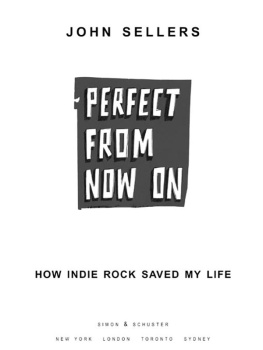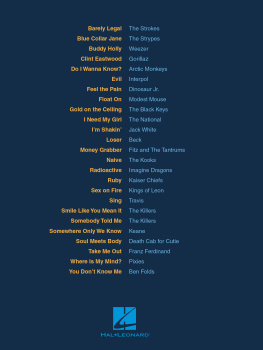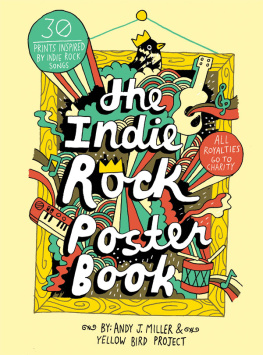GIMME INDIE ROCK
500 ESSENTIAL AMERICAN UNDERGROUND ROCK ALBUMS 19811996
ANDREW EARLES

Dedicated to my life-partner in crime, Elizabeth Murphy, whos truly responsible for this book
First published in 2014 by Voyageur Press, an imprint of Quarto Publishing Group USA Inc., 400 First Avenue North, Suite 400, Minneapolis, MN 55401 USA
2014 Quarto Publishing Group USA Inc.
Text 2014 Andrew Earles
All photographs are from the Voyageur Press collection.
All rights reserved. With the exception of quoting brief passages for the purposes of review, no part of this publication may be reproduced without prior written permission from the Publisher.
The information in this book is true and complete to the best of our knowledge.
All recommendations are made without any guarantee on the part of the author or Publisher, who also disclaims any liability incurred in connection with the use of this data or specific details.
We recognize, further, that some words, model names, and designations mentioned herein are the property of the trademark holder. We use them for identification purposes only. This is not an official publication.
Voyageur Press titles are also available at discounts in bulk quantity for industrial or sales-promotional use. For details write to Special Sales Manager at Quarto Publishing Group USA Inc., 400 First Avenue North, Suite 400, Minneapolis, MN 55401 USA.
To find out more about our books, visit us online at www.voyageurpress.com.
Digital edition: 978-1-62788-379-5
Softcover edition: 978-0-76034-648-8
Library of Congress Cataloging-in-Publication Data
Earles, Andrew, 1973 author.
Gimme indie rock : 500 essential American underground rock albums 19811996 / by Andrew Earles.
pages cm
Summary: Music journalist Andrew Earles provides a rundown of 500 landmark albums recorded and released by bands of the indie rock genreProvided by publisher.
ISBN 978-0-7603-4648-8 (paperback)
1. Alternative rock musicUnited States19811990Discography. 2. Alternative rock music--United States1991-2000Discography. I. Title.
ML156.4.R6E27 2014
781.660973dc23
2014015967
Acquisitions Editor: Dennis Pernu
Project Manager: Madeleine Vasaly
Art Director: Cindy Samargia Laun
Cover Designer: John Barnett
Layout Designer: John Sticha
Cover photo: Jim Saah/www.jimsaah.com
CONTENTS
INTRODUCTION
THE INTENTIONS BEHIND THIS BOOK, HOW TO GET THE MOST OUT OF IT, AND OTHER [HOPEFULLY] HELPFUL POINTS
A s I was writing these 500 entries, I regularly found myself removing fully formed statements and dumping them into another file that was saved as Bookintroductionandnotes.doc. Before long, keeping this books introduction under control loomed as an unwelcome challenge. Only so much context can be fleshed out across an entry-based survey of 500 albums, theres only so much space with which to provide that context, and there are better sources online and in book form (see below and in the appropriate section of the appendix) that will currently build, if combined, somewhat of a contextual narrative of Americas DIY/individualism/outsider/underground rock-based/experimental and so on community (late 70s to present day)
The term indie has been used since at least the mid-80s (mostly in the U.K. music press, at first) as a truncation of independent to describe the small labels that catered to the growing underground rock of the day. Eventually, that term begat indie rock, the more specific designator that rose up partly in reaction to the vagary of the term alternative rock. As if to confuse things, indie rock would eventually be attached to a set of bands with overlapping stylistic values, including Dinosaur Jr, Superchunk, Pavement, and Sebadoh. In other words, it came to be used to describe a subgenre as well as the larger genre that contained it, and during its heyday (see below), there were actual musical requirements that had to be met for a band to be considered indie rock. In the most simplistic terms, successful indie rock was often based on the application of grade-A pop hooks and melody to noisy, distorted guitar, aggressive, heavy or hardcore-tempo rhythms, and other sonic elements that might conflict with sonic beauty. But something else happened, too. Under the larger indie rock genre signifier, one could find a number of other subgenrespost hardcore, college rock, noise rock, lo-fi, emo, love rock, riot grrrl, proto-grunge/grunge, noise pop, shoegaze, left-field, outsider rock the list goes on.
It was in this loose framework that indie rock (the genre) and all its various subgenres (including, as somewhat confusingly revealed above, indie rock) experienced its heyday from roughly 1986 to 1996, give or take a year on either end. The pre-1986 albums discussed in the following pages would in some way or another influence the 8696 titles. Also, as with the pre-1986 albums, there are quite a few 8696 titles featured that no one in their right mind would call indie rock from a musical or aesthetic subgenre standpoint. These would be the albums by bands that operated on the periphery of the American indie rock genre (think opposite end of the spectrum from, say, Buffalo Tom) but appealed to its fans that nurtured more adventurous, demanding or wide-ranging tastes. Then theres the handful of entries covering more mainstream alternative albums that have aged nicely and are worth reexamining.
The lyrics to the song from which this book takes its title, the 1991 7-inch single by the aforementioned Sebadoh, provides a more economical telling of how this all went down in a sort of half-novelty, half-genuine, but one hundred percent rocking fashion. Reading about that 7-inch single prior to purchasing it marked my first real exposure to the term indie rock, and it was a godsend at the time, as I didnt have a name for this music that had been blowing my mind and changing my life over the previous year or so. What do you have that sounds like Dinosaur Jr? was getting snickers during my twice-monthly, paycheck-eating forays to the only record store in town that had a clue at the time.
Of course, this was the same year that Nirvanas Nevermind struck chords at all points from the underground to the mainstream. At a distance of over two decades, that album is now appropriately regarded among the great lines of historical demarcation in music and culture. (Though it should be mentioned that, pre-Nevermind, a number of acts from the indie rock world had already made forays into the realm of major labels, including but not limited to, the Replacements, Hsker D, Soul Asylum, Sonic Youth, Pixies, Dinosaur Jr, and Eleventh Dream Day.) Indie rock and some of its satellite subgenres (including, yes, indie rock) ascendedsome voluntarily, others not so muchto greater levels of exposure, acceptance, and sales.
Subsequently, a substantial number of the bands in this book, those that built grassroots DIY followings or maybe just had one or two albums on an independent label, entered into relationships with major labels and released at least one brilliant album through said channels. Underground rocks written history as it stands today paints the major-label feeding frenzy of the early to mid-90s as a black-and-white, good-versus-evil full-scale corruption and co-opting of the once-pure independent, DIY landscape (or an injurious attempt at doing so). While there is some validity in that line of thinking, the thorough and accurate narrative is much more complicated. And it is a narrative for another book. This one is concerned only with the strength of an album as a singular creative and cultural document, regardless of the label or imprint logo on its sleeve. Throughout this book, the reader will be beaten over the head with the term indie rock, but its impractical and impossible to use it to mean underground rock that is exclusively the domain of independent labels.









